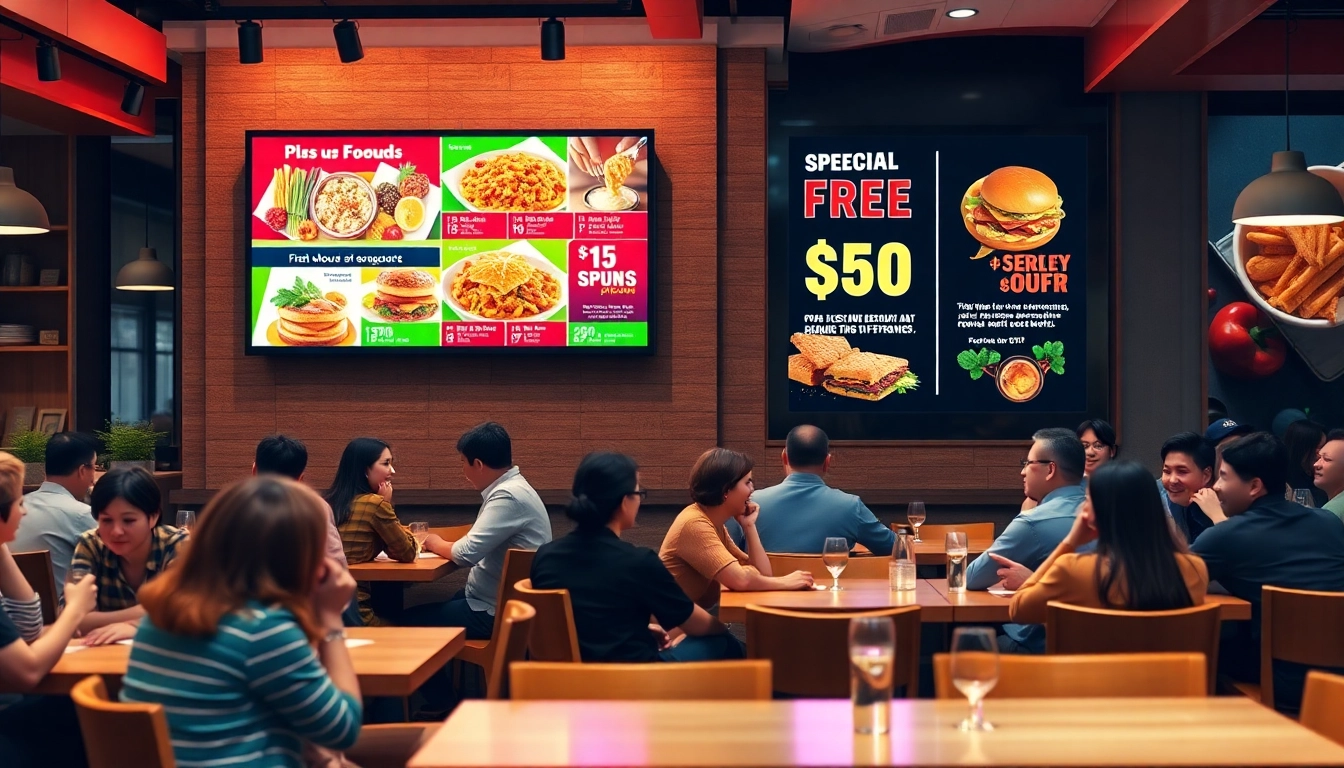Introduction to Digital Signage for Restaurants
In today’s fast-paced and visually driven world, restaurants are increasingly relying on Digital signage for restaurants to communicate effectively with their customers. As consumer expectations evolve, the importance of making a memorable impression through visual communication has never been greater. Digital signage allows restaurants to engage patrons in innovative ways, enhance the dining experience, and drive sales by displaying real-time information such as menus, promotions, and captivating visuals.
The Importance of Visual Communication
Visual communication plays a critical role in how restaurants convey their brand identity and values. The human brain processes images significantly faster than text, making it essential for restaurants to utilize visuals that resonate with their audience. By leveraging digital displays, restaurants can dynamically showcase their menu, daily specials, and high-quality food images, creating a sensory experience that can whet the appetite of potential customers.
Moreover, the aesthetics of a restaurant’s digital signage can enhance the overall ambiance, making the dining space feel modern and inviting. Properly designed displays can draw attention and elicit a sense of excitement, which is particularly important for establishments aiming to attract foot traffic in competitive areas. This enriched visual communication ultimately drives customer engagement and satisfaction.
Key Features of Digital Signage
Digital signage solutions come equipped with numerous features that empower restaurants to fine-tune their visual messaging. Some of the key features include:
- Dynamic Content Management: Digital signage software often includes user-friendly content management systems (CMS) that allow restaurant owners to schedule and modify content effortlessly in real-time, ensuring that promotions and menu items are always current.
- Customizable Templates: With digital signage, restaurants can utilize customizable templates that align with their branding, making it easier to maintain a consistent identity across all digital channels.
- Real-Time Updates: The ability to update content instantly means that restaurants can respond rapidly to trends, customer feedback, or any menu changes without the hassle of reprinting physical signage.
- Data Integration: Modern digital signage can be integrated with point-of-sale (POS) systems to showcase real-time sales data, optimizing promotional efforts based on customer demand and purchasing patterns.
- Interactive Options: Interactivity is a game-changer in customer engagement, enabling features like touchscreens for ordering or viewing additional content related to menu items.
Understanding Your Audience
To maximize the effectiveness of digital signage, it is crucial for restaurants to understand their audience. This involves researching customer demographics, preferences, buying behavior, and emotional triggers. By knowing who their customers are, restaurants can tailor their visual content to align with audience interests and desires, thereby enhancing the impact of their messaging.
For instance, a family-friendly restaurant might focus on kid-friendly menu options and promotions, whereas a fine dining establishment could emphasize gourmet dishes and a more sophisticated ambiance through carefully curated visuals. This targeted approach not only attracts specific customer segments but also fosters customer loyalty and a positive brand perception.
Choosing the Right Digital Signage Solution
With a multitude of digital signage solutions available, selecting the right one for a restaurant requires thoughtful consideration of various factors, including the type of signage, software, and hardware options.
Types of Digital Signage for Restaurants
Different types of digital signage can serve various purposes within a restaurant. Some common categories include:
- Menu Boards: Digital menu boards replace traditional static menus, offering the ability to showcase food items, prices, and images dynamically. They can enhance readability and reduce wait times as customers can easily view the options available.
- Promotional Displays: These are stand-alone or wall-mounted screens dedicated to advertising special offers, discounts, or new menu items. Strategically placing promotional displays in high-traffic areas helps capture customer attention effectively.
- Queue Management Systems: Digital signage can help manage customer flow by displaying wait times or queue information, making it easier for patrons to decide whether to enter a restaurant.
- Informational Displays: These displays provide valuable information such as health and safety guidelines, location directions, or event announcements, contributing to an improved customer experience.
Evaluating Software Options
Choosing the right software for managing digital signage is critical. Key factors to consider include:
- User Interface: Look for software with an intuitive interface that does not require extensive technical knowledge, allowing staff to schedule and update content easily.
- Content Flexibility: The software should support a variety of media formats, such as images, videos, and animations, enabling creative freedom in content creation.
- Compatibility: Ensure that the software is compatible with the chosen hardware and integrates well with existing systems, such as POS or inventory management tools.
- Customer Support: Quality customer support can significantly reduce downtime during technical issues and ensure that staff can utilize the software effectively.
Hardware Considerations
While software is vital, the hardware also plays a crucial role in digital signage implementation. Key hardware considerations include:
- Screen Quality: Invest in high-resolution screens that deliver bright, clear visuals vital for attracting attention. Consider options such as LED screens for enhanced brightness and energy efficiency.
- Mounting Options: Ensure that there are versatile mounting options such as wall mounts, stands, or ceiling mounts that allow for optimal positioning of the screens within the restaurant.
- Interactivity Features: If planning to include interactive signage, choose hardware that supports touchscreens or QR code scanning capabilities for customer engagement.
- Durability and Warranty: Choose hardware designed to withstand usage over time, ideally with warranties in place to protect against hardware failures.
Designing Compelling Content
Creating content that resonates with audiences requires thoughtful design principles and best practices. In the realm of digital signage for restaurants, the following strategies are key to capturing customer attention and driving engagement.
Best Practices for Content Creation
When designing digital signage content, consider the following best practices:
- Keep It Simple: Clear, concise messaging is essential. Limit the amount of text on screens to a few key points to avoid overwhelming customers.
- Use High-Quality Images: Invest in professional photography for menu items to enhance desirability and portray meals attractively.
- Brand Consistency: Ensure all content reflects the restaurant’s branding, including color schemes, fonts, and style, to strengthen brand recognition.
- Timed Promotions: Rotate promotional content frequently to maintain customer interest and excitement around new offers or seasonal items.
Using Data to Drive Engagement
To guarantee that content effectively engages customers, leverage data to inform content decisions. Analyzing patterns in customer behavior can yield insights into which products resonate more, helping fine-tune promotions and staking greater emphasis on popular items. Additionally, feedback from customers gathered via social media or surveys can inform changes to the menu and ledgers.
Implementing a consistent review process for digital signage can also ensure continual improvement. This includes tracking performance metrics and customer reactions to different promotional strategies, allowing restaurants to pivot quickly based on what works and what doesn’t in real time.
Integrating Multimedia Elements
Multimedia elements such as videos, animations, and interactive content can elevate digital signage experiences, making them even more engaging. Restaurants should consider incorporating:
- Video Clips: Short videos showcasing food preparation, customer testimonials, or behind-the-scenes looks can create a captivating narrative that entices customers.
- Customer Interaction: Options like interactive menus or quizzes can actively involve patrons in the experience, creating memorable and fun interactions.
- Live Feeds: Consider incorporating live feeds that display social media posts, special events, or even kitchen activity to build a connection with customers.
Implementing Your Digital Signage
Once the digital signage plan is in place, effective implementation is crucial for success. This phase encompasses installation, overcoming challenges, and staff training.
Installation Tips and Guidelines
Successful installation of digital signage includes several steps:
- Strategic Placement: Determine high-traffic areas where screens will have maximum visibility. Ensure screens are positioned at eye level and that lighting does not hinder visibility.
- Connectivity Requirements: Check that internet connections and cable management are established for reliable performance, and account for power sources during installation.
- Testing Equipment: Test all screens and software before going live to troubleshoot any connectivity issues and ensure visual content displays correctly.
Overcoming Common Challenges
Adopting digital signage is not without its challenges. Common issues include:
- Technical Issues: Hardware or connectivity problems can arise. Having IT support available and implementing regular maintenance protocols can mitigate downtime.
- Resistant Staff: Some employees may feel overwhelmed by new technology. Providing clear training and ongoing support can help them embrace the shift and showcase creative content.
- Cost Concerns: Initial investment costs can be daunting. However, by highlighting the long-term benefits, such as increased sales and customer engagement, stakeholders will better understand the value of digital signage.
Training Staff on Usage
Staff training is vital for effective digital signage implementation. A successful training program should cover:
- Software Demonstration: Show staff how to use the content management software effectively, encouraging them to experiment with scheduling and modifying content.
- Content Guidelines: Provide clear guidelines for creating and updating content to maintain brand voice and messaging consistency.
- Regular Check-Ins: Schedule periodic refresher training sessions to keep staff up-to-date with technological advancements and best practices.
Measuring the Impact of Digital Signage
After implementing digital signage, measuring its effectiveness is crucial to determine ROI and areas for improvement. This involves defining key performance indicators (KPIs) and analyzing customer engagement.
Key Performance Indicators to Track
Establishing KPIs helps restaurants gauge the impact of their digital signage. Some important metrics to focus on include:
- Sales Increase: Monitor changes in sales before and after digital signage implementation to measure the direct impact on revenue.
- Customer Traffic: Analyze foot traffic patterns and note if there are increased customer visits during promotional periods when digital signage is actively utilized.
- Engagement Metrics: Track interactions and feedback, especially if the signage includes interactive elements or social media feeds.
Analyzing Customer Engagement
Understanding how customers interact with digital signage can provide valuable insights. Collecting data on customer reactions, dwell time, and promotional uptake can inform future content decisions. Methods for collecting engagement data may include:
- Surveys and Feedback Forms: Encouraging customer feedback can yield direct insights into their preferences and experiences.
- Analytics Tools: Utilizing specialized software to analyze viewer statistics—like how many times a piece of content was viewed—can help assess its effectiveness.
Continuous Improvement Strategies
The journey with digital signage doesn’t end with installation. Continuous improvement strategies include:
- Regular Content Audits: Conduct audits of displayed content regularly to ensure it remains relevant and engaging.
- Staying Trendy: Keep an eye on industry trends and audience interests. Update content accordingly to reflect new customer preferences and seasonal specials.
- Engaging Staff in the Process: Encourage staff to provide insights and ideas for future signage, creating a culture of collaboration and innovation.
By effectively implementing digital signage, restaurants can revolutionize the way they communicate with customers, increase engagement, and drive sales. Through careful planning, strategic implementation, and continuous evaluation, the advantages of Digital signage for restaurants can be harnessed to create a compelling, interactive experience that resonates with patrons and keeps them coming back.








